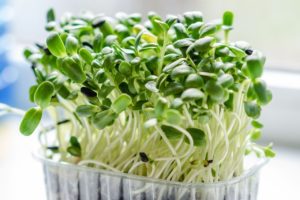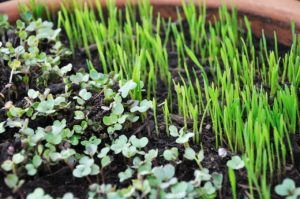What Size Is Best Container For Microgreens?
 To start your microgreens, you will need a few things. Good soil and the right size and best container for your microgreens. Unlike traditional garden soil, which tends to harden quickly when spread in a shallow layer, soil mixes are a great choice for growing microgreens. For the best results, use a mixture made from organic materials such as peat moss and compost. You can purchase a variety of such soil mixes at your local gardening supply store. For best results, prepare your soil mix by spreading out a newspaper or an old towel over the growing medium before seeding the seeds. Once the soil mixture has been placed, cover the seeds with it and gently press them into the mix.
To start your microgreens, you will need a few things. Good soil and the right size and best container for your microgreens. Unlike traditional garden soil, which tends to harden quickly when spread in a shallow layer, soil mixes are a great choice for growing microgreens. For the best results, use a mixture made from organic materials such as peat moss and compost. You can purchase a variety of such soil mixes at your local gardening supply store. For best results, prepare your soil mix by spreading out a newspaper or an old towel over the growing medium before seeding the seeds. Once the soil mixture has been placed, cover the seeds with it and gently press them into the mix.
There are many microgreen starter kits out there and if you have it in your budget to get a kit, that is a great way to get started. In case you do not have that in your budget, you will need to know what size is the best container for your microgreens.
So, if you do not have the ability to buy a microgreens starter kit, there are many DIY alternatives that are environmentally friendly. You can start growing microgreens in a yogurt or sour cream container. You can also use a plastic tofu container, which has a larger surface area and is more durable than a standard plastic pot. If you’d like to invest in a proper container, there are many options available.
 You can buy a food tray to grow your microgreens in but make sure the food trays are food grade. Remember that polycarbonate is not food-safe, as it contains BPA, which can migrate into the food that you consume. If you’re buying a food-grade container, be sure to double its size to accommodate the growing medium.
You can buy a food tray to grow your microgreens in but make sure the food trays are food grade. Remember that polycarbonate is not food-safe, as it contains BPA, which can migrate into the food that you consume. If you’re buying a food-grade container, be sure to double its size to accommodate the growing medium.
Another consideration is the type of container. If you are growing microgreens indoors, choose the container that can accommodate the plants. You can use a Tupperware container that has a shallow bottom and a shallow depth. A sandwich-size Tupperware container is also a good option. Otherwise, you can use a 2-liter juice box that has been cut in half. For a more compact and easy-to-clean grow dish, a 4-liter plastic milk jug can be used. If you’re planning to use the containers outside, ensure you poke holes in the bottom so that water can drain out easily.
You can recycle the small plastic fruit containers and place them in the garden to grow microgreens. They should be kept dry. A pint-sized plastic clamshell is ideal for growing cherry tomatoes, blueberries, and cherries. Half-pint-sized containers are good for raspberries, gooseberries, and blackberries. If you’re growing microgreens indoors, be sure to avoid using a quart-sized clamshell. A quart-sized container is too deep for your plants.
A micro green container must be three inches deep and wide in order to maintain a healthy environment. The best container for microgreens is shallow and deep. It can be made from a variety of materials including pyrex bread pans, spice jars, and coffee cups. It should have adequate air ventilation. The soil mix should be damp. These are the best containers for growing microgreens.
 In order to maintain a moist environment, the soil should be slightly moist. You can also use a glass or plastic bowl to keep the water at bay. If you live in a place that does not receive direct sunlight, you’ll need to provide artificial lighting. LED or fluorescent lights are the most suitable choice for microgreens. Halogen or heat lamps are not recommended because they can damage the plants. A shallow container will make it easier to harvest the microgreens.
In order to maintain a moist environment, the soil should be slightly moist. You can also use a glass or plastic bowl to keep the water at bay. If you live in a place that does not receive direct sunlight, you’ll need to provide artificial lighting. LED or fluorescent lights are the most suitable choice for microgreens. Halogen or heat lamps are not recommended because they can damage the plants. A shallow container will make it easier to harvest the microgreens.
In conclusion, growing microgreens in shallow but wide, recycled containers is a great way to save some money and get going on a great addition to your indoor gardening skills!
